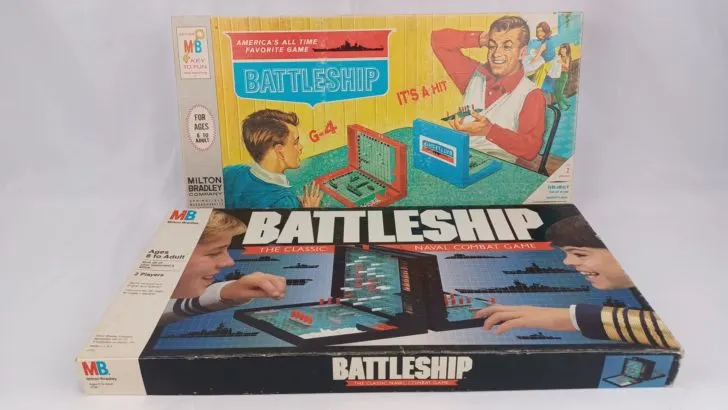Originally created back in 1931, the board game Battleship is generally considered a classic. One of the main reasons it has become a classic is the easy to pick up and play gameplay. Basically pick a letter number combination and hope that it hits one of your opponent’s ships. Once you hit a ship try to sink it by calling out the neighboring spaces. The first player to sink all of their opponent’s ships first wins the game. For a full explanation for how to play Battleship, check out our how to play guide.
While Battleship is considered a classic, there are a lot of people that don’t think particularly high of it. This mostly comes down to Battleship being considered a guessing game. At its most basic level Battleship is mostly a guessing game. Outside of cheating you are relying on guesses to find the other player’s ships. The player that is better at guessing will usually win the game.
There are strategies that you can implement to increase your odds of winning Battleship though. These strategies are not foolproof as there is no strategy that can overcome the other player guessing better than you. You can significantly improve your odds of winning though. In fact if you follow the strategies below you can more than double your chances of winning the game.
Know Your Opponent
Before getting into specific strategies I wanted to first talk about the meta game behind Battleship. The whole game is built around guessing where the other player put their ships while also keeping your own ships safe. Thus your success in the game is going to depend on how well you can read the other player.
If you play with the same player a lot, you will likely start to notice tendencies. They may choose to place their ships in similar spots or guess the same way each game. You can take advantage of this to improve your odds in the game.
For example say your opponent likes to place their ships along the outside of the board or in large groups. You should take this into consideration while guessing. Maybe start guessing towards the edges of the board or guessing in the same area when you get a hit. If they like to use a certain pattern while guessing, place your ships in the areas that they usually guess last.
At the same time you need to be aware of your own tendencies. If you place your own ships or guess in a similar way every game, they may adjust to take advantage. Because of this you need to be willing to tweak your strategy every game. You may not have to make drastic changes, but you can’t do the same thing every game.
This is not foolproof. Your opponent might be aware of you using these tactics, which might lead them to change their strategy as well. This is not guaranteed to help you in the game. You should at least consider your opponent though when implementing your strategy.
Strategies For Placing Ships
Of the two phases in Battleship, there are considerably less potential strategy options when choosing where to place your ships. Most of the strategies regarding placing your ships rely on you defying your opponent’s expectations. Basically you want to place ships in a way that your opponent is not expecting.
Edges Versus the Center
Outside of defying your tendencies, placing a ship on the edge versus the center does not make it significantly easier or harder to find.
Generally players are more likely to guess the center of the board. Unless your opponent regularly targets the edges, your ship is more likely to get hit if it is towards the center. This is only because the other player is more likely to guess those spaces. If you concentrate all of your ships towards the center of the board, they likely will find them quicker.
At the same time you don’t want to focus too heavily on the edges. If the player finds a ship on the edges, they will likely start to guess more spaces along the edges. If you place all of your ships on the edges they will catch on quickly and find your other ships.
Ultimately you are probably best off having a mixture of both. You should probably place one or two ships along or near the edges. Then place the rest of the ships closer to the center of the board. Basically you want your ship placement to feel as random as possible. This includes putting some of your ships vertical and others horizontal. If you place your ships following some sort of pattern, once your opponent hits one of your ships they may figure out your pattern and find your other ships.
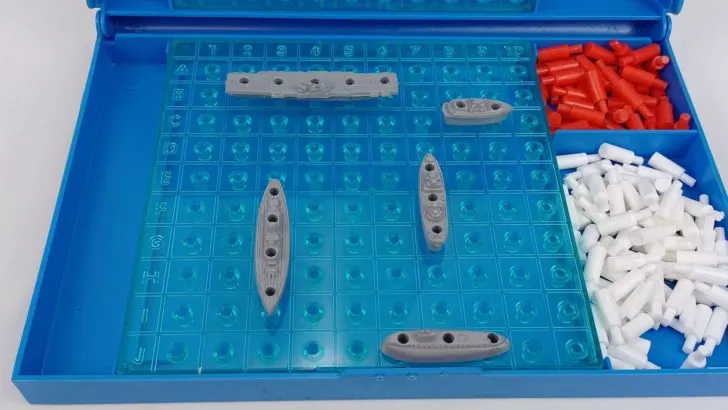
Spreading Out Ships or Placing Them All Together
Another thing to consider is how to space out your ships. Basically you need to decide between placing them all together, or spreading them out throughout the board. Your decision mostly comes down to whether you want to use a safer or riskier strategy.
Putting all of your ships together is considerably more risky than spreading out your ships. It can pay off big if your opponent targets another section of the board. It could ruin your chances if your opponent quickly targets the area where you put all of the ships. Putting all of your ships together does give you a better chance of surviving longer with the other player not finding any of your ships. If you choose the right area to place your ships, you could get a large head start as the other player keeps missing.
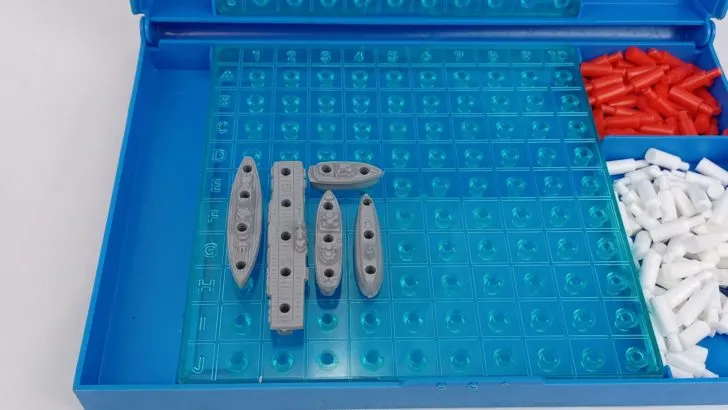
The real risk with this strategy is once your opponent hits one of your ships. After they get a hit they are going to target the neighboring spots. They might just sink the ship that they originally targeted. They are just as likely to hit one of your other ships though. Eventually they will realize that they hit two different ships. This will let them know that they should heavily concentrate on that area of the board. Thus they could sink the rest of your ships really quickly.
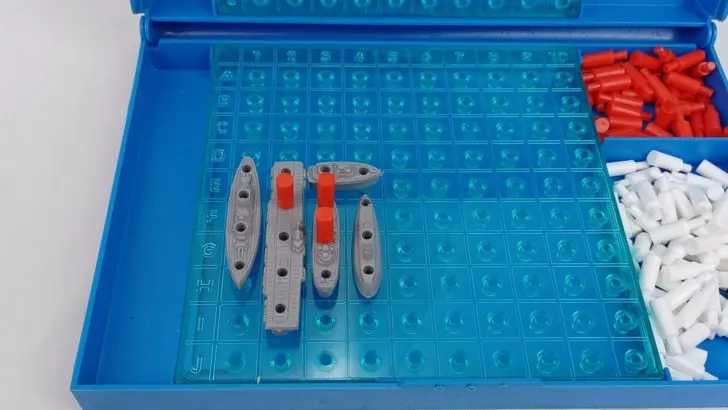
If they just sink the one ship though, they could possibly move to a different part of the board thinking that they already hit the only ship in that area.
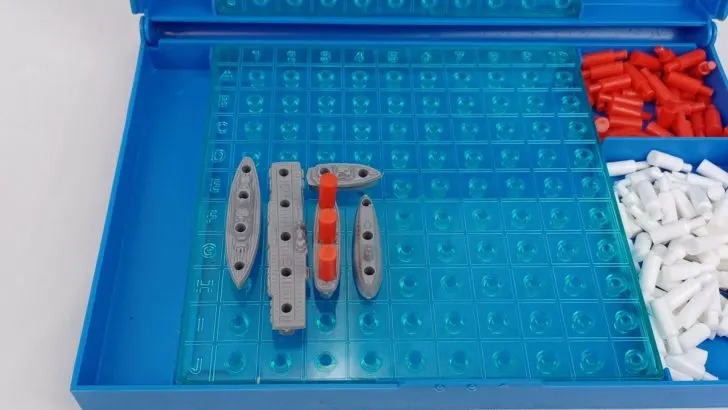
I would usually avoid the strategy of placing all of your battleships in the same area. The strategy is really risky, and more times than not will hurt you more than it helps. If you play against the same player all of the time though, it may pay to occasionally utilize it to catch them by surprise.
Strategies For Picking Shot Locations in Battleship
Now that your ships are placed, it is time to get to the main part of Battleship’s gameplay. Choosing the right spots to target ultimately decides who will win the game. Unless you are cheating there is no way to know for sure where your opponent put their ships. There are a number of strategies that you can implement to improve your odds of finding ships though.
Start Towards the Middle
This strategy is going to somewhat depend on your opponent. Typically players are more likely to place ships towards the center of the board. It may be because they think that they will be harder to find. This is not the case for every player though. Some players are more likely to place ships along the outside of the board though. If you are playing a player that typically places ships along the edges, you can disregard this strategy suggestion.
Even if this wasn’t the case, it is statistically better to shoot towards the center. Edge spaces have less placement opportunities for ships. This means there are less opportunities for you to hit a ship.
Lets take a look at a space on the left edge of the grid. A ship could be on the space if it is placed vertically running along the left edge. This gives you as many chances of hitting it as the size of the ship. Otherwise you could place a ship where one of the ends is on the chosen space. Those are the only ways you could hit a ship with a guess along the left edge. For a size three ship, there are four different potential placements of the ship that you could hit with an edge shot. The same applies to ships along the top, right and bottom edges.
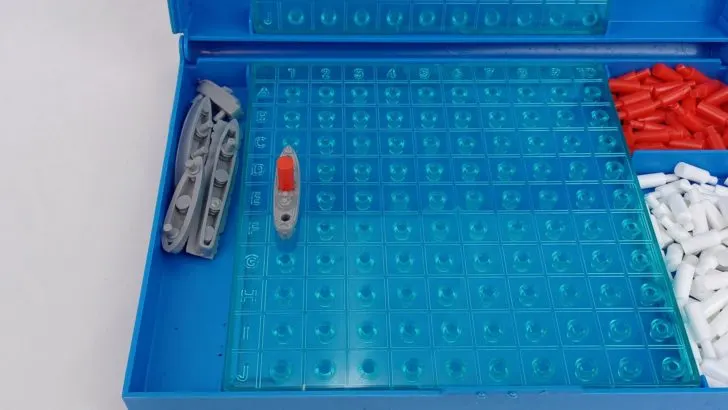
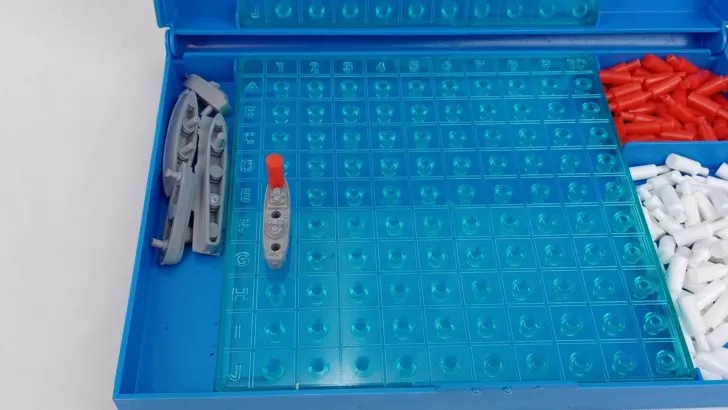
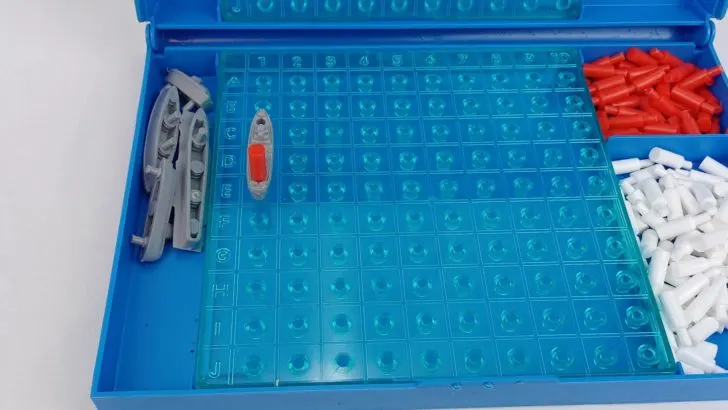
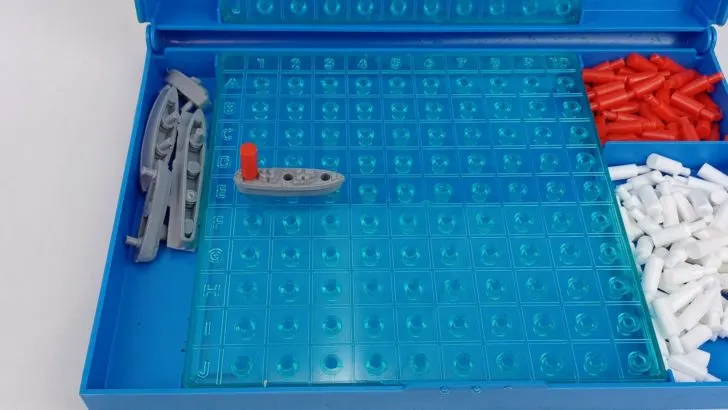
Now lets look at a space more towards the center of the board. Picking a space further into the board gives you many more opportunities to hit a ship. Ships can be placed in many different vertical and horizontal combinations and be on a given space. In the size three ship example, there are six different ship combinations for the space. With more options, there is a greater chance of getting a hit.
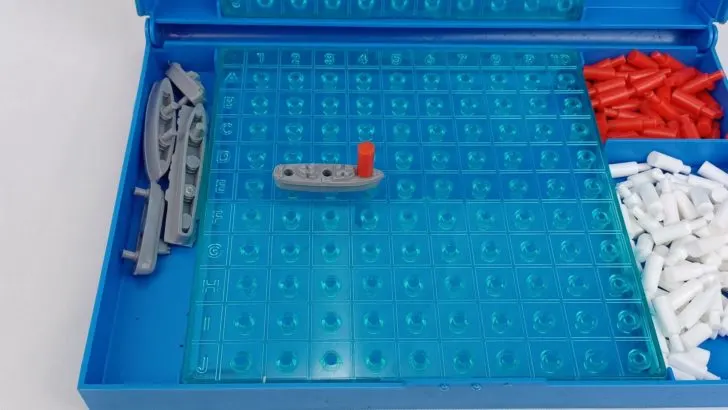
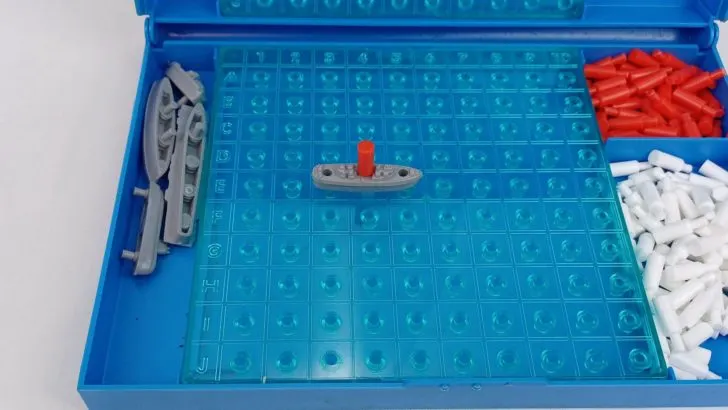
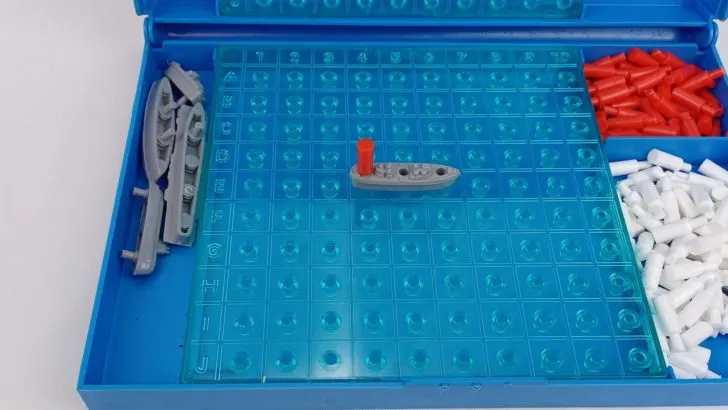
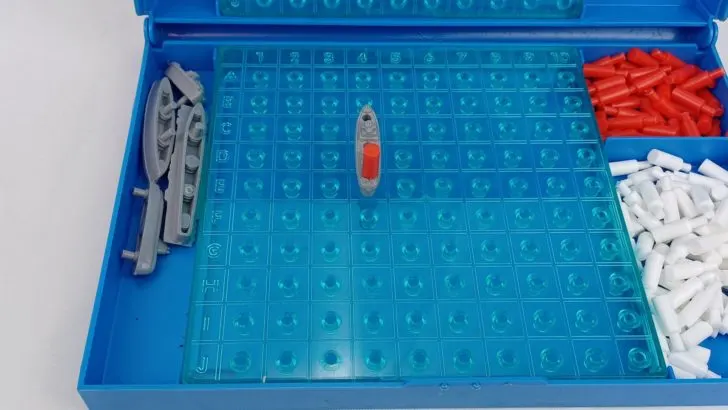
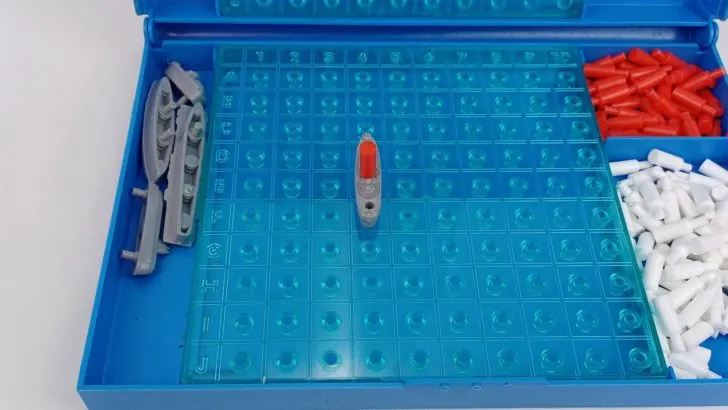
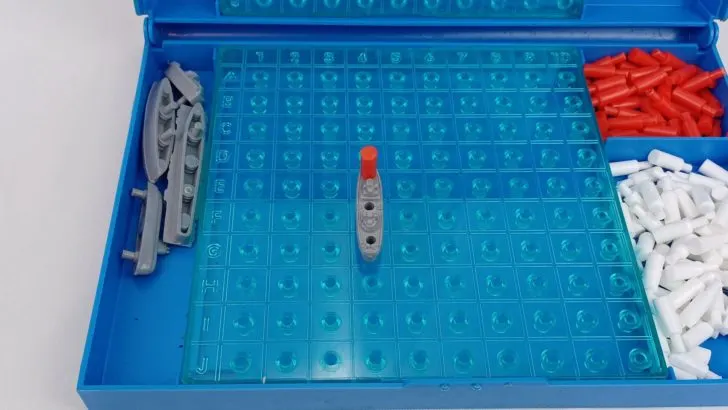
I would recommend shooting mostly towards the center of the board especially earlier in the game. You can’t completely ignore the outer edges though. This is especially true if the opponent you are playing tends to place ships along the edges.
Hunt and Target Battleship Strategy
One of the basic Battleship strategies most players pick up intuitively is referred to as the Hunt and Target strategy. This strategy is rather simple.
You will begin by using some of the strategies below to spread out your shots and maximize the odds of getting a hit. When you hit a ship you want to try to sink it as soon as possible. You want to do this because it lets you figure out what ships still remain. Knowing the size of the remaining ships will really help you better utilize your future shots. For example say you sunk the ship that only takes up two spaces. You now know that you can leave more spaces between shots as the larger ships can’t be hidden in certain areas.
The value of this strategy kind of depends on which version of Battleship you are playing. This is because the rules for Battleship have changed over time. In some versions of Battleship when a ship gets hit, the player has to tell their opponent which ship was hit. With this information you already know how big the ship is. So sinking it doesn’t give you nearly as much information. You are probably still better off sinking the ship quickly, but you don’t have to do it immediately.
Implementing the Hunt and Target Strategy
The Hunt and Target strategy is very simple.
When you hit a ship your next shot should be targeted towards a neighboring space. As ships can’t be placed diagonally; you should either choose the space above, below, left, or right of your last hit.
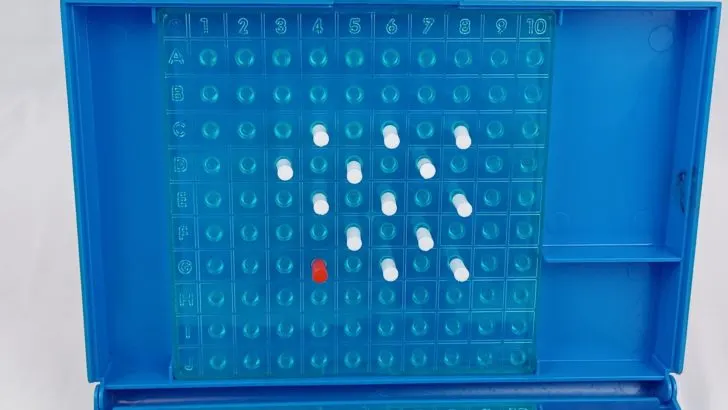
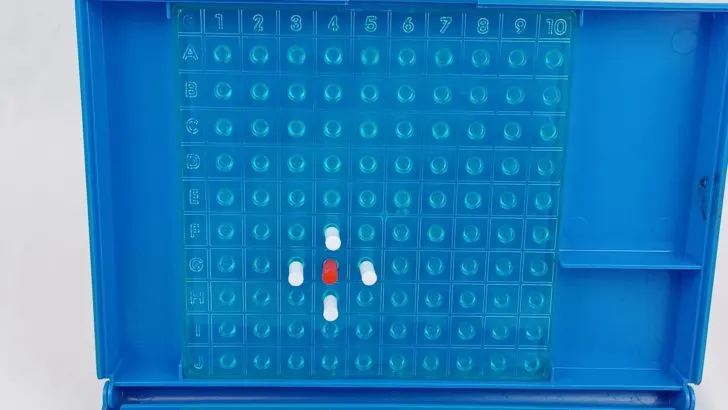
If you get a hit in the vertical or horizontal direction, you will want to keep shooting in the same direction. This will continue until you have sunk the ship.
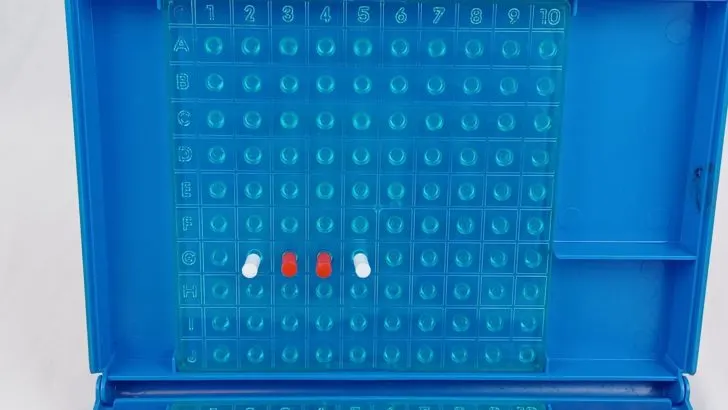
Parity Battleship Strategy
The next strategy that is key to improving your chances is referred to as the Parity Strategy.
The Parity Strategy basically comes from two facts about the game. First every ship in Battleship takes up at least two spaces. Second, ships cannot be placed diagonally.
The Parity Strategy basically says that there is no point in guessing every space. For example lets say you guess B1 and A2, and both are misses. Since a ship has to take up at least two spaces, there is no way that the ship can be in A1. Therefore there is no point in guessing that space.
That is a very simplified example, but it works for the entire board. There is no reason to guess a space next to one that you have already guessed. The one exception is when your previous guess was a hit. The adjacent space may actually have a ship on it. You are better off finding it by leaving an empty space. It doesn’t pay to waste a guess on the small chance that the next space would get a hit.
Implementing the Parity Strategy
The best way to implement the Parity Strategy is by utilizing diagonals to your advantage. Diagonals are key because they allow to eliminate a space in the column and row.
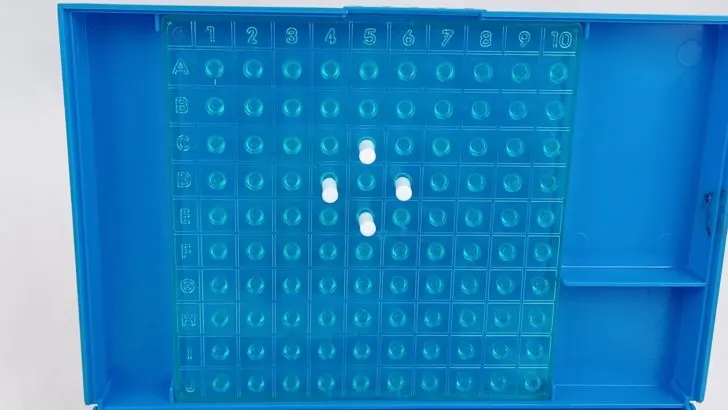
Basically you should look at the Battleship board like a Checker/Chess board. You should either guess the lighter or the darker spaces. If you do this, you can ignore all of the opposite spaces unless you get a hit. This basically eliminates half of the spaces that you would need to potentially guess to find all of the ships.


When you get a hit, you move to the Hunt and Target strategy to sink the ship.
Visualize Where Ships Are More Likely to Fit
As you start to destroy ships and narrow down spots where the remaining ships can be, you should analyze the remaining areas where a ship is most likely to be placed. If you mostly have small ships left, this might not be all that helpful. If only large ships remain, you need to consider the most likely spot that the ship could be.
Take the size five ship for example. With its size it is limited where it can be placed. While there may be potential hiding spots in an area that you have heavily searched, it is much more likely to be hiding in an area that you haven’t searched as thoroughly. In most cases you would be better off making your guesses in an area that you haven’t guessed in as much.
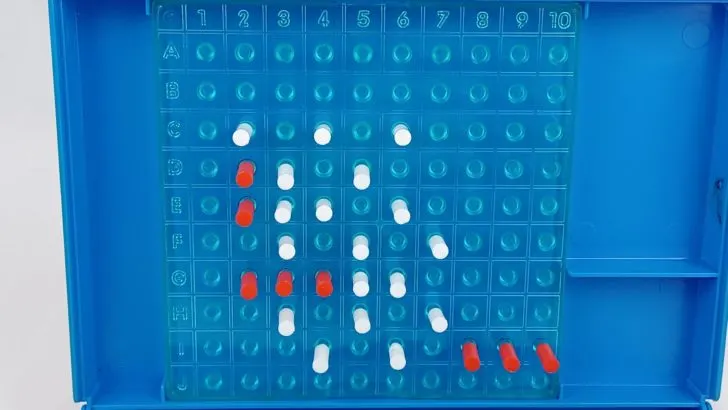
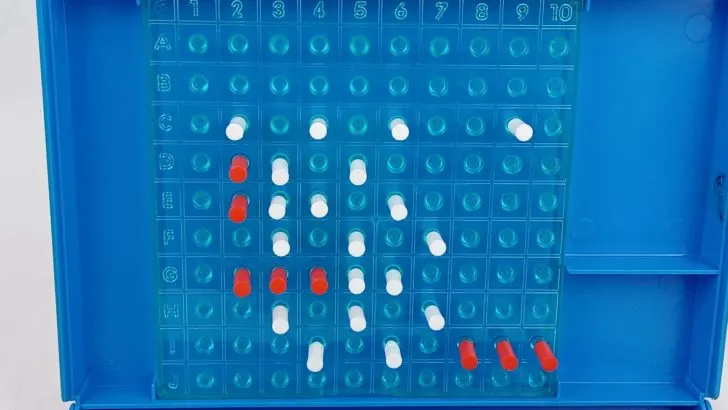
This is not a foolproof strategy. It wouldn’t work well against a player that places a lot of their ships next to one another.
You are usually better off guessing in different sectors of the grid instead of focusing on just one area. You should stick to the Parity strategy, but you should guess around the grid from time to time instead of just clearing out one area at a time. This will make it much more likely that you will hit the larger ships and hopefully get lucky and hit one of the smaller ships.
Change Your Battleship Strategy As You Sink Ships
To begin each game of Battleship it makes sense to follow a Hunt and Target as well as a Parity strategy. As you progress in the game though, you need to adjust your strategy based on what has already happened.
This all comes down to what ships you have already sunk. You obviously have no control over what ships you ultimately end up hitting/sinking. The best case scenario is to sink the smaller ships first as they are statistically harder to find since they cover less spaces. Hitting them early in the game also makes it easy to adjust your strategy. This should make it even easier to find your opponent’s remaining ships.
The Parity strategy is based around the fact that you will eventually have to find a ship that only covers two spaces on the grid. Because of its small size, you need to guess every other space in order to make sure that you don’t miss the smallest ship. Should you be able to sink the smallest ship though, this is no longer the case. If you no longer have to worry about the two space ship, you can now skip more spaces between each of your shots. Instead of guessing every other space, you can now leave two empty spaces vertically and horizontally between each of your guesses. None of the remaining ships could fit in these gaps, so there is no point in guessing any of these spaces.
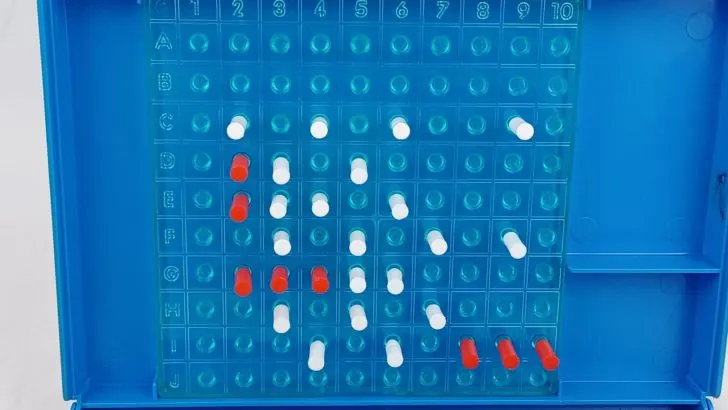
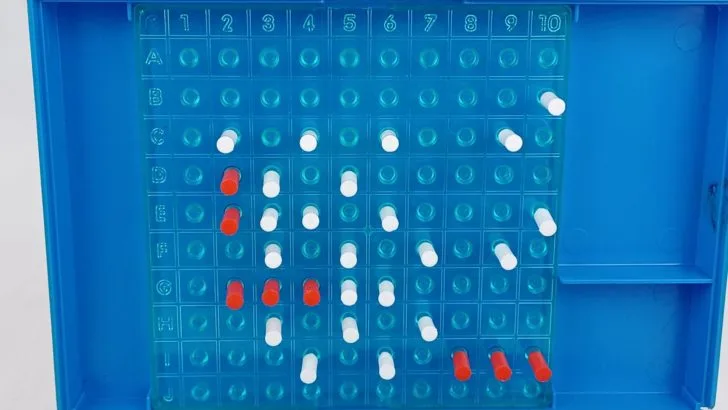
Implementing this small tweak to the Parity Strategy can significantly reduce the number of spaces that you will have to guess during the game. This doesn’t just apply to when you sink the two space ship. If you sink that ship along with the two three space ships, you can now leave three spaces vertically and horizontally between each of your guesses.
Widen Your Shot Radius to Start the Game
I will preface this strategy by saying that it is more high risk high reward than some of the other strategies. If the strategy works you could end up cutting down the maximum number of shots you have to take to find all of ships to 33-34. If it fails though you could end up having to take around 64 shots if you are really unlucky. Statistically you would be better off utilizing this strategy about half of the time, and the other half you might be worse off.
Basically this suggestion is to take the Parity Strategy a little further. The normal Parity Strategy is to guess every other space as it guarantees that you will eventually hit every ship. The strategy also cuts down the number of shots you have to make by half. This optional strategy has the potential to cut down the number of shots you have to take by two thirds if luck is on your side.
This strategy is based around the distribution of ships in the game. Battleship has the following distribution of ships: 1 ship – 2 spots, 2 ships – 3 spots, 1 ship – 4 spots, and 1 ship – five spots. Basically all but one of the ships take up three or more spaces on the board. You can use this information to impact how you make guesses.
Basically for this Battleship strategy I recommend cutting straight to leaving two spaces vertically and horizontally between each of your guesses. This takes into consideration that you will still make use of diagonal guesses. You are basically forming diagonal lines through the grid with two spaces between each of the lines. This strategy guarantees that you will hit all of the three, four and five spot ships at the start of the game.

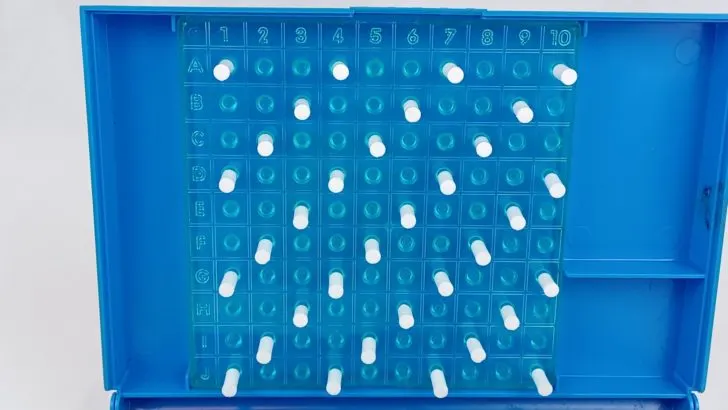
The one concern is the two space ship. By putting more space between each of your shots, there is a chance that that the two space ship could be between two of your shots. If this happens you will have to go back through the grid to make additional guesses inside these two space gaps.

Should you hit the size two ship in your first volley without having to go back over the spaces, you will likely save quite a few guesses. If you miss though you still might be better off. The initial group of shots will take either 33-34 shots. You will then have an additional 16-17 shots to still break even with the traditional Parity Strategy. If you still don’t hit the ship though, you will actually be worse off than if you just used the normal Parity Strategy.
Because of this, this strategy is not guaranteed to help you. If it works it will greatly increase your odds of winning. If it doesn’t you will be worse off. Therefore it is high risk with a potential high reward. If you are falling behind the other player though I would highly recommend implementing it as it could help you catch back up.
Battleship Strategy Conclusion
There is no way to guarantee victory in Battleship. Too much of your success depends on you randomly guessing where your opponent placed their ships before they find yours. Utilizing a strategy can pretty significantly improve your odds of winning the game though.
When choosing where to place your ships, the best strategy is likely to randomize their positions. Basically you don’t want to use some sort of pattern that you opponent can figure out which they can then use to guide their choices. I don’t know if there is a real benefit to putting ships towards the center or along the edges. Probably the best option is to have some of both. The more random the distribution of your ships, the less information that your opponent can gain to inform their decisions.
Choosing where to shoot next actually benefits quite a bit from the strategy that you choose to utilize. While you could win by randomly guessing, following a shot pattern will likely improve your chances of winning the game. When you hit a ship you will probably want to sink it before moving on as that will give you information about what ships still remain to be hit. When picking shots you want to use a grid system. Do not pick a space next to one that you already chose in the past. Instead pick a space that is diagonal to one your previous guesses. This significantly reduces the number of shots that you will have to make.
As you eliminate ships, adjust your shot pattern. If you have eliminated the smaller ships, put more spaces between each of your shots. Also take note of where you haven’t shot yet and where the remaining ships can still fit on the board.
If you want to take a riskier shot strategy, leave two spaces horizontally and vertically between each of your choices. You might not hit the two space ship on your first pass, but if you do you will likely find it much quicker. You will also find all of the other ships quicker as well. The risk is that you might have to go back and pick spaces in the gaps if you don’t find the smallest ship. If you get unlucky this strategy could force you to guess even more spaces than if you just chose every alternating space.

